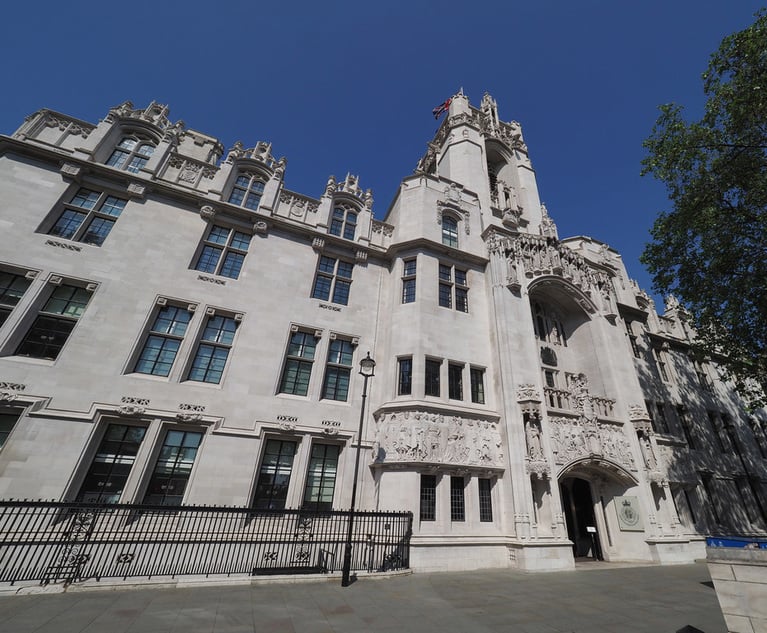Can Labour's New Budget Steady the Ship? Big Moves On UK Tax Reform and Fiscal Stability
As the U.S. election wraps up this week, the global economy may finally have a chance to stabilise following a period of intense political uncertainty among G20 nations.
November 05, 2024 at 07:36 AM
5 minute read
 Sandy Bhogal and Bridget English; Photo courtesy Gibson Dunn & Crutcher
Sandy Bhogal and Bridget English; Photo courtesy Gibson Dunn & Crutcher
New governments always have grand ambitions, and this Labour government is no exception.
We heard constant rhetoric during the election about growing the economy and improving social justice (and using the tax regime to do that). So imagine their disappointment when they took power and got a proper look at the country's finances.
This was the cue for an intensive press campaign about balancing the books, £22 billion ($28.5 billion) blackholes, and the need for fiscal responsibility to reassure the international financial markets. Not a budget for growth, but a revenue raiser which didn't "formally" breach manifesto commitments but would hopefully leave people saying "that could have been worse".
The changes were leaked in advance and a number of the headline measures had been previewed with industry, so there were few shocks, huge amounts of technical material and plenty to consider. The highlights being:
- The largest portion of increased tax collections will come from changes to employer national insurance contributions (NICs). From April 2025, rates will increase from 13.8% to 15% and the threshold above which employers pay NICs will fall from £9,100 to £5,000. To mitigate the impact of this change on small businesses, the Employment Allowance will increase from £5,000 to £10,500. The Office for Budget Responsibility (plus every talking head on TV) predict that many businesses will pass the cost on to employees by adjusting wage increases and limiting job creation, thereby reducing disposal income in circulation (which in turn, risks reducing consumption, and revenues from taxes like VAT).
- As was widely trailed, from April 2025, capital gains tax rates will rise (albeit less steeply than some had feared): from 10% to 18% for basic rate taxpayer, and from 20% to 24% for higher rate taxpayers, while carried interest will be taxed at a uniform 32% (up from 18%, or 28% for additional rate taxpayers). However, from April 2026, carry will instead be taxed as income. This means it will be subject to income tax at 45% and NICS at 2%, but reduced by a multiplier to an effective rate of around 34% if certain conditions are met. A technical consultation has commenced on the details of this new regime, with the hope that it simplifies the existing anti-avoidance rules and finds ways to ease the administrative burdens associated with carry and other equity incentives.
- The Chancellor has broadly retained the previous government's proposal to scrap the remittance basis of taxation (the so-called "non-dom" rules), with relatively minor tweaks (e.g. extending, from three to four years, the grace period during which new residents' off-shore income will not be taxed in the U.K.) Attempts have been made toward simplifying employment tax rules for internationally mobile employees (by removing the need for HM Revenue & Customs' (HMRC's) prior approval of the allocation of employment income between U.K., and non-U.K., work for payroll purposes). However, new limits on the extent to which overseas work remains outside the U.K. tax net (being the lower of 30% of employment income or £300,000) will likely have the opposite effect—potentially driving an increase in the complexity of multinational payroll arrangements. The direct and indirect contribution of non-doms and the internationally mobile to U.K. tax revenue, and to London's reputation as a financial and commercial hub, should not be underestimated and it is hoped that the government, will, by way of counteraction, give further thought to measures to protect and bolster the UK's competitiveness.
- As in recent years, the so-called "tax gap" (being the gap between tax legally owed, and tax collected) permeated the budget. HMRC plans to employ 1,800 new debt collectors and 5,000 new compliance staff, while late payment interest will increase by 1.5% (to 9% currently). In addition, (despite the litany of regimes introduced over the last decade) further measures are proposed to (a) crack down on promoters and facilitators of avoidance (on which consultations will be launched in early 2025), and (b) improve standards of tax advice, by requiring all tax advisers dealing with HMRC on clients' behalf to register (as well as giving further consideration to potential regulatory intervention in the tax market). Given the existing tools at HMRC's disposal to tackle avoidance, it may perhaps be wondered whether the proposals are likely to close the tax gap in any meaningful way (as the majority of the tax gap arises in the SME sector).
The government is positioning this budget as a "one and done" revenue raiser for the duration of this parliament. The U.K.'s reputation for fiscal stability has suffered in recent years, with six different prime ministers in eight years and the dramatic market reaction to the uncosted "mini-budget" of September 2022. The government is, therefore, justifiably eager to provide corporate taxpayers with an element of certainty when forward planning their tax affairs. This was evident in the publication of a Corporate Taxation Roadmap, which committed the government to maintaining the 25% corporation tax rate (as well as other taxpayer-favourable measures, such as full expensing for certain capital expenditure and R&D tax reliefs) for the current parliament.
With the U.S. election reaching its conclusion this week, the global economy will have the opportunity to settle down after a concentrated period of political uncertainty across the G20 countries. The Labour government now has to seize the opportunity over the course of this parliament to make good on its election promises and improve the UK's reputation as a predictable and business-friendly tax jurisdiction.
Sandy Bhogal is co-chair of Gibson Dunn's global tax practice, based in London. He advises multinational companies, asset managers and fund sponsors, investment banks, and institutional investors including sovereign wealth funds on their most complex tax issues.
NOT FOR REPRINT
© 2025 ALM Global, LLC, All Rights Reserved. Request academic re-use from www.copyright.com. All other uses, submit a request to [email protected]. For more information visit Asset & Logo Licensing.
Related Stories
View AllYou Might Like
View All

X-odus: Why Germany’s Federal Court of Justice and Others Are Leaving X

Threat of Trump Tariffs Is Sign Canada Needs to Wean Off Reliance on Trade with U.S., Trade Lawyers Say
5 minute read
UK Sanctions Regime Put to the Test as Supreme Court Hears First ‘De-Designation’ Case Brought by Billionaire
Law Firms Mentioned
Trending Stories
- 1Jackson Lewis Leaders Discuss Firms Innovator Efforts, From Prompt-a-Thons to Gen AI Pilots
- 2Trump's DOJ Files Lawsuit Seeking to Block $14B Tech Merger
- 3'No Retributive Actions,' Kash Patel Pledges if Confirmed to FBI
- 4Justice Department Sues to Block $14 Billion Juniper Buyout by Hewlett Packard Enterprise
- 5A Texas Lawyer Just Rose to the Trump Administration
Who Got The Work
J. Brugh Lower of Gibbons has entered an appearance for industrial equipment supplier Devco Corporation in a pending trademark infringement lawsuit. The suit, accusing the defendant of selling knock-off Graco products, was filed Dec. 18 in New Jersey District Court by Rivkin Radler on behalf of Graco Inc. and Graco Minnesota. The case, assigned to U.S. District Judge Zahid N. Quraishi, is 3:24-cv-11294, Graco Inc. et al v. Devco Corporation.
Who Got The Work
Rebecca Maller-Stein and Kent A. Yalowitz of Arnold & Porter Kaye Scholer have entered their appearances for Hanaco Venture Capital and its executives, Lior Prosor and David Frankel, in a pending securities lawsuit. The action, filed on Dec. 24 in New York Southern District Court by Zell, Aron & Co. on behalf of Goldeneye Advisors, accuses the defendants of negligently and fraudulently managing the plaintiff's $1 million investment. The case, assigned to U.S. District Judge Vernon S. Broderick, is 1:24-cv-09918, Goldeneye Advisors, LLC v. Hanaco Venture Capital, Ltd. et al.
Who Got The Work
Attorneys from A&O Shearman has stepped in as defense counsel for Toronto-Dominion Bank and other defendants in a pending securities class action. The suit, filed Dec. 11 in New York Southern District Court by Bleichmar Fonti & Auld, accuses the defendants of concealing the bank's 'pervasive' deficiencies in regards to its compliance with the Bank Secrecy Act and the quality of its anti-money laundering controls. The case, assigned to U.S. District Judge Arun Subramanian, is 1:24-cv-09445, Gonzalez v. The Toronto-Dominion Bank et al.
Who Got The Work
Crown Castle International, a Pennsylvania company providing shared communications infrastructure, has turned to Luke D. Wolf of Gordon Rees Scully Mansukhani to fend off a pending breach-of-contract lawsuit. The court action, filed Nov. 25 in Michigan Eastern District Court by Hooper Hathaway PC on behalf of The Town Residences LLC, accuses Crown Castle of failing to transfer approximately $30,000 in utility payments from T-Mobile in breach of a roof-top lease and assignment agreement. The case, assigned to U.S. District Judge Susan K. Declercq, is 2:24-cv-13131, The Town Residences LLC v. T-Mobile US, Inc. et al.
Who Got The Work
Wilfred P. Coronato and Daniel M. Schwartz of McCarter & English have stepped in as defense counsel to Electrolux Home Products Inc. in a pending product liability lawsuit. The court action, filed Nov. 26 in New York Eastern District Court by Poulos Lopiccolo PC and Nagel Rice LLP on behalf of David Stern, alleges that the defendant's refrigerators’ drawers and shelving repeatedly break and fall apart within months after purchase. The case, assigned to U.S. District Judge Joan M. Azrack, is 2:24-cv-08204, Stern v. Electrolux Home Products, Inc.
Featured Firms
Law Offices of Gary Martin Hays & Associates, P.C.
(470) 294-1674
Law Offices of Mark E. Salomone
(857) 444-6468
Smith & Hassler
(713) 739-1250








